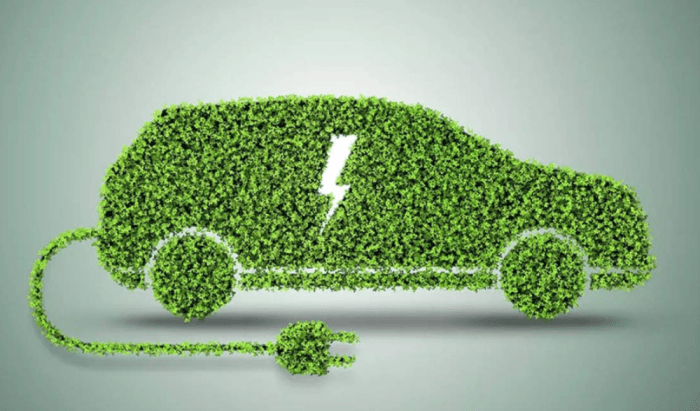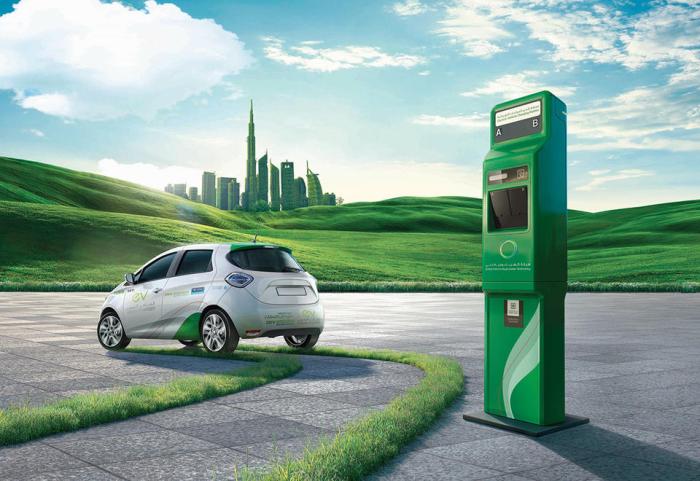Green Energy for Electric Vehicles
Green energy for electric vehicles represents a crucial step towards sustainable transportation. This exploration delves into the multifaceted aspects of powering electric vehicles (EVs) with renewable energy sources, examining the environmental impact, economic viability, technological advancements, and public perception surrounding this critical transition. We will investigate the diverse renewable energy options available, analyzing their efficiency, geographical suitability, and overall contribution to a cleaner transportation sector.
From the sourcing of renewable energy to the development of efficient charging infrastructure and the role of smart grids, we will unpack the complexities involved in making the widespread adoption of green EVs a reality. Furthermore, we will assess the lifecycle environmental impact of EVs, highlighting areas for improvement and showcasing successful initiatives driving this sustainable transformation.
Sources of Green Energy for Electric Vehicles
The transition to electric vehicles (EVs) hinges critically on the availability of clean electricity for charging. This necessitates a shift towards renewable energy sources, minimizing the overall carbon footprint of transportation. Understanding the various renewable energy options, their environmental impacts, and their suitability for EV charging infrastructure is crucial for a successful and sustainable transition.
Renewable Energy Sources for EV Charging
Several renewable energy sources can power EV charging stations, each with its own advantages and drawbacks. These include solar power, wind power, hydropower, geothermal energy, and biomass energy. The choice of the most suitable source depends on factors such as geographical location, resource availability, and technological feasibility.
Environmental Impacts of Renewable Energy Sources
The environmental impact of renewable energy sources is significantly lower than that of fossil fuels. However, lifecycle assessments reveal nuances. Solar panel manufacturing, for example, requires energy and produces waste. Wind turbines can impact bird and bat populations. Hydropower projects can alter river ecosystems.
A thorough lifecycle assessment considers these factors to provide a comprehensive environmental impact evaluation. For instance, the carbon footprint of solar power decreases significantly over its operational lifetime, making it a net positive contributor to emissions reduction. Similarly, while wind power has potential impacts on wildlife, advancements in turbine design and siting strategies are mitigating these effects.
Energy Density and Efficiency of Renewable Energy Sources
Renewable energy sources vary considerably in their energy density and efficiency. Solar power, for instance, has a relatively low energy density compared to wind power, meaning it requires a larger area to generate the same amount of electricity. However, solar panels are highly efficient in converting sunlight into electricity, with advancements pushing conversion rates above 20% for some models.
Wind power boasts higher energy density but is dependent on consistent wind speeds. Hydropower, while offering high energy density and efficiency, is geographically limited to areas with suitable water resources. Geothermal energy offers consistent, high-density power generation, but its geographic limitations restrict its widespread adoption.
Geographical Suitability of Renewable Energy Sources
| Source | Energy Density | Efficiency | Geographical Suitability |
|---|---|---|---|
| Solar | Low | High (increasing) | Suitable in sunny regions with ample land; less suitable in cloudy or shaded areas. |
| Wind | Moderate to High | Moderate to High | Suitable in areas with consistent strong winds; requires adequate land area and may face permitting challenges. |
| Hydropower | High | High | Limited to areas with suitable rivers, dams, and sufficient water flow; potential environmental impacts on river ecosystems. |
| Geothermal | High | High | Limited to geologically active regions; requires specialized infrastructure and expertise. |
Green Energy Infrastructure for EV Charging
The global transition to electric vehicles (EVs) necessitates a parallel expansion of renewable energy infrastructure for charging. Currently, the landscape is a mix of dedicated renewable-powered stations and those drawing from the existing grid, with varying degrees of reliance on green energy sources. While progress is evident, significant challenges remain in ensuring sufficient clean energy to power the burgeoning EV fleet.Current Global Infrastructure for Renewable Energy-Powered EV Charging StationsThe current global infrastructure for renewable energy-powered EV charging stations is still in its nascent stages, although rapidly developing.
Many charging stations are grid-tied, meaning they draw power from the existing electricity grid, which may or may not be predominantly powered by renewable sources. Dedicated solar-powered or wind-powered charging stations are increasingly common, particularly in areas with abundant sunlight or wind resources. However, the geographical distribution is uneven, with higher concentrations in countries with strong renewable energy policies and investments.
For example, Norway, with its ambitious EV adoption targets, has seen significant investment in charging infrastructure powered by hydropower. Similarly, several regions in California and Europe boast charging stations integrated with solar farms. These examples demonstrate the potential, but also highlight the significant geographical disparities in infrastructure development.
Challenges in Scaling Up Renewable Energy Infrastructure for EV Charging
Scaling up renewable energy infrastructure to meet the rapidly growing demand for EV charging presents numerous complex challenges. One major hurdle is the intermittent nature of renewable energy sources like solar and wind. Solar power generation fluctuates with sunlight availability, and wind power depends on wind speed. This intermittency necessitates energy storage solutions, such as batteries, to ensure a consistent supply of power to charging stations, adding significant cost and complexity.
Furthermore, the large-scale deployment of renewable energy infrastructure requires substantial investments in new generation capacity, transmission lines, and grid upgrades to handle the increased load. Land use constraints, particularly for large-scale solar and wind farms, also pose a challenge. Finally, the need for efficient and reliable grid management systems is crucial to balance supply and demand and avoid grid instability.
The Role of Smart Grids in Optimizing Renewable Energy Distribution for EV Charging
Smart grids play a crucial role in optimizing renewable energy distribution for EV charging by providing a dynamic and responsive system for managing energy flow. Smart grids utilize advanced sensors, communication technologies, and data analytics to monitor energy consumption and generation in real-time. This allows for intelligent load management, enabling the charging of EVs when renewable energy generation is high and demand is low, minimizing reliance on fossil fuel-based power plants.
Smart grids also facilitate vehicle-to-grid (V2G) technology, where EVs can feed excess energy back into the grid during periods of high demand, further enhancing grid stability and resilience. This two-way energy flow significantly improves grid efficiency and optimizes the utilization of renewable energy resources. For example, in some pilot projects, smart charging algorithms coordinate charging times based on real-time renewable energy generation forecasts, resulting in reduced reliance on fossil fuels and minimized carbon emissions.
Conceptual Model for a Localized, Self-Sufficient Renewable Energy Charging Station
A conceptual model for a localized, self-sufficient renewable energy charging station could integrate multiple renewable energy sources, such as solar panels, wind turbines, and potentially even small-scale hydropower or geothermal systems, depending on the location. Energy storage would be a critical component, employing a battery system of sufficient capacity to handle peak demand and address the intermittency of renewable energy sources.
A smart energy management system would monitor energy generation, consumption, and battery levels, optimizing charging schedules and energy distribution to maximize self-sufficiency. The station could also incorporate features like energy-efficient lighting, charging infrastructure compatible with various EV models, and user-friendly interfaces for monitoring energy consumption and payment processing. This model aims to minimize reliance on the external grid, reducing the carbon footprint of EV charging and promoting energy independence at a localized level.
Green energy is crucial for powering electric vehicles, significantly reducing their environmental impact compared to gasoline-powered cars. A key aspect of this reduction involves sourcing the electricity itself from renewable sources; for a deeper dive into minimizing your overall carbon footprint, check out this informative guide on How to reduce carbon footprint with green energy. Ultimately, the widespread adoption of green energy for electric vehicles is a vital step towards a more sustainable transportation future.
Such a station, strategically located in areas with abundant renewable resources, could serve as a blueprint for decentralized, sustainable EV charging infrastructure.
The Impact of Green Energy on EV Lifecycle
The environmental benefits of electric vehicles (EVs) are significantly influenced by the energy sources used throughout their lifecycle. While EVs produce zero tailpipe emissions, their overall carbon footprint depends heavily on the electricity used for manufacturing, charging, and eventual recycling. This analysis explores how the integration of renewable energy sources can minimize the environmental impact at each stage.
The carbon footprint of an EV is a complex issue, encompassing various stages from raw material extraction and component manufacturing to vehicle assembly, use, and end-of-life disposal. The energy mix used in electricity generation plays a crucial role in determining the overall environmental impact. For instance, an EV charged primarily with coal-fired electricity will have a substantially larger carbon footprint than one charged with solar or wind power.
Furthermore, the manufacturing process itself, involving the extraction and processing of metals like lithium, cobalt, and nickel, contributes significantly to the overall emissions.
EV Manufacturing and Renewable Energy
Renewable energy sources can dramatically reduce the environmental impact of EV manufacturing. The production of EV batteries, a particularly energy-intensive process, benefits significantly from renewable energy powering the factories. Utilizing solar and wind energy for battery production directly reduces greenhouse gas emissions associated with electricity consumption. Additionally, sustainable sourcing of raw materials and the implementation of more efficient manufacturing processes can further minimize the carbon footprint.
For example, companies are increasingly investing in closed-loop recycling systems for battery materials, reducing the need for new mining operations.
EV Charging and Renewable Energy
The charging infrastructure is another key area where renewable energy can make a substantial difference. The use of renewable energy for charging EVs directly offsets the emissions that would otherwise result from fossil fuel-based electricity. The development of large-scale solar and wind farms near charging stations, or integrating renewable energy sources into the grid supplying charging networks, is vital.
This not only reduces the operational emissions of EVs but also improves the overall sustainability of the transportation sector. Initiatives like installing solar panels on charging station rooftops exemplify this integration.
Successful Initiatives Promoting Green Energy Integration
Several successful initiatives demonstrate the potential of green energy integration in the EV lifecycle. For example, some EV manufacturers are partnering with renewable energy providers to power their factories with 100% renewable energy. Others are investing in battery recycling programs, aiming to recover valuable materials and minimize waste. Furthermore, governments are implementing policies to incentivize the use of renewable energy for EV charging, including subsidies for installing solar panels at home and promoting the development of renewable energy-powered charging stations.
These initiatives demonstrate a commitment to reducing the environmental impact of EVs.
Future Innovations for Reducing EV Environmental Impact
Future innovations hold the potential to further reduce the environmental impact of EVs. Research into more sustainable battery chemistries, such as solid-state batteries, could significantly reduce the environmental burden associated with battery production and disposal. Advances in battery recycling technologies, including improved methods for extracting and reusing critical materials, are crucial. Furthermore, the development of more efficient electric motors and lightweight vehicle designs can contribute to lower energy consumption and reduced emissions.
Finally, the expansion of smart grids and improved energy storage solutions can enhance the integration of renewable energy into the EV charging infrastructure. For instance, Tesla’s Gigafactory utilizes solar power extensively in its operations.
Economic Aspects of Green Energy for EVs

Source: theindianwire.com
The economic viability of transitioning to green energy for electric vehicle (EV) charging is a crucial factor in the widespread adoption of EVs and the reduction of carbon emissions from the transportation sector. A comprehensive assessment requires considering the initial investment costs, operational expenses, and long-term benefits of various renewable energy sources compared to traditional fossil fuel-based electricity generation.The economic landscape of EV charging is rapidly evolving, influenced by technological advancements, government policies, and fluctuating energy prices.
Analyzing the cost-effectiveness and potential economic gains is essential for policymakers, investors, and businesses involved in the energy and transportation sectors.
Cost Comparison of Renewable and Fossil Fuel-Based EV Charging
Renewable energy sources, such as solar and wind power, offer a compelling alternative to fossil fuel-based electricity for EV charging. While the initial capital expenditure for installing renewable energy infrastructure (solar panels, wind turbines, etc.) can be significant, the long-term operational costs are typically lower due to the free and abundant nature of solar and wind resources. Conversely, fossil fuel-based electricity generation relies on constantly fluctuating fuel prices, leading to unpredictable operational costs.
A detailed lifecycle cost analysis, considering factors like maintenance, repair, and potential subsidies for renewable energy, is needed for a precise comparison. For instance, a study by the National Renewable Energy Laboratory (NREL) might show a lower levelized cost of energy (LCOE) for solar-powered charging stations compared to grid-supplied electricity in sunny regions after a certain number of years.
This LCOE considers all costs over the system’s lifetime, making it a useful metric for comparison.
Economic Benefits of Investing in Renewable Energy Infrastructure for EVs
Investing in renewable energy infrastructure for EV charging offers significant economic benefits beyond environmental advantages. The construction and maintenance of renewable energy facilities create numerous jobs in manufacturing, installation, and operation. Furthermore, the increased adoption of EVs powered by renewable energy can stimulate economic growth in related sectors, such as battery production, charging station development, and smart grid technologies.
The shift towards green energy is crucial for the widespread adoption of electric vehicles, minimizing their environmental impact. A key factor influencing this transition is the supportive framework of renewable energy policies, such as those detailed in Renewable energy policies in Canada. These policies directly impact the availability and affordability of clean electricity, ultimately making electric vehicle ownership more sustainable and appealing to consumers.
Ultimately, strong renewable energy initiatives are essential for a truly green transportation future.
For example, the growth of the solar industry in countries with strong EV adoption policies has demonstrably created thousands of jobs and spurred innovation. This economic ripple effect extends to local communities, fostering economic development and improving overall quality of life. Economic modeling studies often project significant job creation and GDP growth associated with large-scale renewable energy deployments for the transportation sector.
Government Policies to Incentivize Green Energy for EV Charging
Government intervention plays a crucial role in accelerating the adoption of green energy for EV charging. Strategic policies can significantly influence investment decisions and consumer behavior.
- Tax credits and rebates for installing renewable energy systems at EV charging stations.
- Subsidies and grants to support the development and deployment of renewable energy-powered EV charging infrastructure.
- Feed-in tariffs or renewable portfolio standards that mandate a certain percentage of electricity from renewable sources.
- Streamlined permitting processes and reduced regulatory barriers for renewable energy projects related to EV charging.
- Investment in research and development of advanced renewable energy technologies for EV charging.
- Carbon pricing mechanisms that make fossil fuel-based electricity more expensive, thus increasing the competitiveness of renewable energy.
These policies can create a more favorable economic environment for investing in green energy for EV charging, ultimately leading to a faster transition towards a sustainable transportation system.
Technological Advancements in Green Energy for EVs
The seamless integration of renewable energy sources with electric vehicles (EVs) hinges critically on continuous technological advancements. These advancements are not limited to the EVs themselves, but encompass the entire energy ecosystem, from energy generation and storage to charging infrastructure and grid management. Significant progress is being made across multiple fronts, paving the way for a truly sustainable transportation future.
The burgeoning electric vehicle market necessitates a robust green energy infrastructure to support its growth. This demand is driving significant investment in renewable sources, and understanding the landscape of these investments is crucial. For a detailed look at current trends, check out this report on Green energy investments in Australia , which offers valuable insights into the future of clean energy and its impact on electric vehicle adoption.
Ultimately, the success of electric vehicles hinges on the continued expansion of sustainable energy sources.
Battery technology plays a pivotal role in determining the effectiveness of renewable energy integration for EVs. Improved battery capacity, faster charging times, and enhanced lifespan directly translate to increased vehicle range and reduced reliance on fossil fuels, maximizing the utilization of renewable energy sources. Furthermore, advancements in energy storage solutions are crucial for effectively managing the intermittent nature of renewable energy sources like solar and wind.
Battery Technology and Renewable Energy Optimization
Advancements in battery chemistry, such as solid-state batteries and improved lithium-ion technologies, are driving significant improvements in energy density, charging speed, and overall lifespan. Solid-state batteries, for instance, offer the potential for higher energy density and improved safety compared to traditional lithium-ion batteries, allowing EVs to travel further on a single charge using the same amount of renewable energy. Increased energy density means that more renewable energy can be stored for later use, optimizing the use of intermittent renewable energy sources.
Similarly, faster charging times reduce the time EVs need to be connected to the grid, minimizing potential strain on the energy system during peak demand periods. Improved battery lifespan reduces the need for frequent replacements, further minimizing the environmental impact and maximizing the long-term benefits of using renewable energy.
Advancements in Energy Storage Solutions
The intermittent nature of solar and wind power necessitates robust energy storage solutions to ensure a consistent supply of electricity for EV charging. Beyond batteries, other technologies are emerging as key players. For example, pumped hydro storage utilizes excess renewable energy to pump water uphill, storing potential energy that can be released later to generate electricity when demand is high.
This technology is particularly well-suited for large-scale energy storage. Similarly, compressed air energy storage (CAES) uses excess energy to compress air, which can then be released to drive turbines and generate electricity. These technologies, along with advancements in battery technology, are essential for smoothing out the variability inherent in renewable energy sources and ensuring reliable power for EV charging.
Hydrogen Fuel Cells Powered by Renewable Energy
Hydrogen fuel cells offer a promising alternative to battery-electric vehicles, particularly for long-haul transportation or applications requiring rapid refueling. Renewable energy sources can be used to produce green hydrogen through electrolysis, a process that splits water into hydrogen and oxygen using electricity. This green hydrogen can then be used to power fuel cells in vehicles, producing electricity with only water vapor as a byproduct.
While the infrastructure for hydrogen refueling is still under development, the potential for decarbonizing heavy-duty transportation and long-distance travel through green hydrogen is significant. The efficiency of the entire process, from renewable energy generation to hydrogen production and fuel cell operation, needs to be further improved to fully realize its potential.
Advancements in Smart Charging Technologies
Smart charging technologies are crucial for optimizing the use of renewable energy for EVs. These technologies leverage real-time data on electricity prices and renewable energy generation to schedule charging when renewable energy is abundant and electricity prices are low. This approach minimizes the reliance on fossil fuel-based electricity generation and maximizes the use of clean energy.
Here are some examples of smart charging technologies and their benefits:
- Vehicle-to-Grid (V2G) technology: Allows EVs to feed excess energy back into the grid during periods of high demand, effectively acting as distributed energy storage resources. This can help stabilize the grid and improve the overall efficiency of renewable energy integration.
- Smart charging algorithms: Utilize predictive analytics and real-time data to optimize charging schedules, minimizing charging costs and maximizing the use of renewable energy.
- Load balancing algorithms: Distribute charging demands across the grid to prevent overloading and ensure stable electricity supply, especially during peak hours.
Public Perception and Adoption of Green EVs

Source: lmu.edu
The widespread adoption of electric vehicles (EVs) powered by renewable energy sources hinges significantly on public perception and acceptance. Positive attitudes and understanding of the environmental and economic benefits are crucial drivers of consumer choice, while negative perceptions or concerns can act as significant barriers. Addressing these perceptions through targeted campaigns and supportive policies is vital for accelerating the transition to a sustainable transportation sector.Public awareness campaigns play a crucial role in shaping public opinion.
The shift towards electric vehicles necessitates a robust green energy infrastructure. This reliance on clean power sources is directly linked to advancements in Innovative renewable energy technologies , such as improved solar and wind power generation. Ultimately, the success of electric vehicle adoption hinges on the continued development and widespread implementation of these sustainable energy solutions.
For example, campaigns highlighting the reduced carbon footprint of EVs compared to gasoline-powered vehicles, often visually represented through infographics showing lower CO2 emissions, can significantly influence consumer preferences. Others showcase the long-term cost savings associated with lower electricity prices compared to fluctuating gasoline costs. Some successful campaigns have utilized celebrity endorsements or partnerships with influential environmental organizations to broaden their reach and impact.
Factors Influencing Consumer Adoption of Green EVs
Several factors influence consumer decisions regarding the purchase of green EVs. These include the upfront cost of EVs, which is often higher than comparable gasoline-powered vehicles, range anxiety (fear of running out of charge before reaching a charging station), the availability and accessibility of charging infrastructure, and the perceived performance and convenience compared to traditional vehicles. Government incentives, such as tax credits or subsidies, can significantly mitigate the impact of the higher initial purchase price.
Similarly, advancements in battery technology, leading to increased range and faster charging times, address range anxiety and improve overall convenience.
The Role of Education and Public Policy in Increasing the Acceptance of Green Energy for EVs, Green energy for electric vehicles
Education plays a critical role in shaping public understanding of the benefits of green EVs. Educational initiatives, including school programs, public awareness campaigns, and online resources, can dispel misconceptions and provide accurate information about EV technology, charging infrastructure, and environmental impact. These programs can focus on the life-cycle assessment of EVs, highlighting the reduced emissions compared to gasoline cars even considering the electricity generation process.Public policy also plays a vital role in fostering EV adoption.
Government incentives, such as tax credits and subsidies, can make EVs more affordable and attractive to consumers. Regulations promoting the development of charging infrastructure, such as mandates for charging stations in public spaces and buildings, are crucial for alleviating range anxiety. Furthermore, policies promoting the development and deployment of renewable energy sources, such as solar and wind power, directly support the sustainability of EVs by ensuring a cleaner electricity grid.
Visual Representation of the Positive Environmental Impact of Green EVs
Imagine a vibrant, circular infographic. The outer ring displays a dark, smoky cityscape representing traditional vehicle emissions. The inner circle shows a bright, green landscape with lush trees and clean air, symbolizing the environment powered by green EVs. A sleek, electric vehicle is prominently featured in the center of the green circle, connected by a thin, bright green line to a stylized solar panel and wind turbine, illustrating the renewable energy source powering it.
The colors are strategically used: dark grays and browns for pollution, vibrant greens and blues for the clean environment, and a bright electric blue for the EV itself. The overall message conveyed is one of stark contrast – the polluted city versus the clean, sustainable future made possible by green EVs. The circular shape symbolizes the cyclical nature of renewable energy and its sustainable impact.
Outcome Summary: Green Energy For Electric Vehicles

Source: logisticsmiddleeast.com
Ultimately, the shift towards green energy for electric vehicles is not merely an environmental imperative but a multifaceted opportunity. By harnessing the potential of renewable energy sources, coupled with technological innovation and supportive public policies, we can pave the way for a cleaner, more sustainable, and economically vibrant transportation future. The economic benefits, technological advancements, and positive environmental impact collectively present a compelling case for prioritizing green energy in the electric vehicle sector.
The journey towards widespread adoption will require continued collaboration among stakeholders, fostering innovation, and encouraging public awareness.
Essential Questionnaire
What are the main challenges in scaling up renewable energy infrastructure for EV charging?
Scaling renewable energy infrastructure for EV charging faces challenges like intermittency of renewable sources, geographical limitations, high initial investment costs, and the need for grid upgrades to handle increased electricity demand.
How does battery technology impact the use of renewable energy for EVs?
Advancements in battery technology, such as increased energy density and faster charging capabilities, are crucial for maximizing the effectiveness of renewable energy sources by enabling longer driving ranges and quicker charging times, mitigating the intermittency issue.
What government policies can incentivize green energy for EV charging?
Incentives include tax credits for installing renewable energy charging stations, subsidies for EV purchases powered by renewable energy, grants for research and development in green energy technologies, and carbon pricing mechanisms that make fossil fuels less competitive.
What is the role of smart grids in optimizing renewable energy distribution for EV charging?
Smart grids use advanced technologies to optimize the distribution of renewable energy, ensuring efficient charging by managing energy demand and supply in real-time, integrating renewable sources more effectively, and minimizing energy waste.









